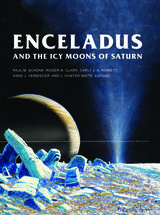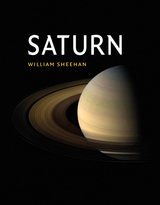4 books about Saturn

Enceladus and the Icy Moons of Saturn
Edited by Paul M. Schenk, Roger N. Clark, Carly J. A. Howett, Anne J. Verbiscer, and J. Hunter Waite
University of Arizona Press, 2018
With active geysers coating its surface with dazzlingly bright ice crystals, Saturn’s large moon Enceladus is one of the most enigmatic worlds in our solar system. Underlying this activity are numerous further discoveries by the Cassini spacecraft, tantalizing us with evidence that Enceladus harbors a subsurface ocean of liquid water. Enceladus is thus newly realized as a forefront candidate among potentially habitable ocean worlds in our own solar system, although it is only one of a family of icy moons orbiting the giant ringed planet, each with its own story.
As a new volume in the Space Science Series, Enceladus and the Icy Moons of Saturn brings together nearly eighty of the world’s top experts writing more than twenty chapters to set the foundation for what we currently understand, while building the framework for the highest-priority questions to be addressed through ongoing spacecraft exploration. Topics include the physics and processes driving the geologic and geophysical phenomena of icy worlds, including, but not limited to, ring-moon interactions, interior melting due to tidal heating, ejection and reaccretion of vapor and particulates, ice tectonics, and cryovolcanism.
By contextualizing each topic within the profusion of puzzles beckoning from among Saturn’s many dozen moons, Enceladus and the Icy Moons of Saturn synthesizes planetary processes on a broad scale to inform and propel both seasoned researchers and students toward achieving new advances in the coming decade and beyond.
As a new volume in the Space Science Series, Enceladus and the Icy Moons of Saturn brings together nearly eighty of the world’s top experts writing more than twenty chapters to set the foundation for what we currently understand, while building the framework for the highest-priority questions to be addressed through ongoing spacecraft exploration. Topics include the physics and processes driving the geologic and geophysical phenomena of icy worlds, including, but not limited to, ring-moon interactions, interior melting due to tidal heating, ejection and reaccretion of vapor and particulates, ice tectonics, and cryovolcanism.
By contextualizing each topic within the profusion of puzzles beckoning from among Saturn’s many dozen moons, Enceladus and the Icy Moons of Saturn synthesizes planetary processes on a broad scale to inform and propel both seasoned researchers and students toward achieving new advances in the coming decade and beyond.
[more]

Moths in Your Pocket
A Guide to the Saturn and Sphinx Moths of the Upper Midwest
Jim Durbin, Frank Olsen, and Tom Jantscher
University of Iowa Press, 2014
This welcome addition to Iowa’s popular series of laminated guides—the twenty-seventh in the series—illustrates fifty-one species commonly found in the Upper Midwest states of Illinois, Iowa, Indiana, Michigan, Minnesota, Ohio, and Wisconsin.
The Saturniid, or Giant Silk moths, are well named. Their large size—up to 6.5 inches for the cecropia moth—and the soft silky browns, greens, and oranges of their wings are unforgettable when they appear at a lighted window at night. Equally well named are the Sphinx or Hawk moths, important pollinators that hover like hummingbirds when nectar-feeding at dusk and even in daylight. The caterpillars of both families can be just as distinctive as the adults, as anyone who has ever come upon a tobacco or a tomato hornworm can attest.
For each species the authors have included common and scientific names, wingspan, and time of flight for the adults at this final stage in their life cycle. Striking photographs of the adult moths and of their larval stages make this guide as beautiful as it is useful.
For all naturalists captivated by the clear window eyespots of a Swallow-tailed Luna moth, the dark eyespots and bright yellow “pupils” of an Io moth, or the extendable proboscis of a White-lined Sphinx moth flitting from one moss rose to another, the photographs and descriptions in Moths in Your Pocket will be an invaluable reference.
The Saturniid, or Giant Silk moths, are well named. Their large size—up to 6.5 inches for the cecropia moth—and the soft silky browns, greens, and oranges of their wings are unforgettable when they appear at a lighted window at night. Equally well named are the Sphinx or Hawk moths, important pollinators that hover like hummingbirds when nectar-feeding at dusk and even in daylight. The caterpillars of both families can be just as distinctive as the adults, as anyone who has ever come upon a tobacco or a tomato hornworm can attest.
For each species the authors have included common and scientific names, wingspan, and time of flight for the adults at this final stage in their life cycle. Striking photographs of the adult moths and of their larval stages make this guide as beautiful as it is useful.
For all naturalists captivated by the clear window eyespots of a Swallow-tailed Luna moth, the dark eyespots and bright yellow “pupils” of an Io moth, or the extendable proboscis of a White-lined Sphinx moth flitting from one moss rose to another, the photographs and descriptions in Moths in Your Pocket will be an invaluable reference.
[more]

Saturn
William Sheehan
Reaktion Books, 2019
Saturn is the showpiece planet of our solar system. It may not be the largest, nor the smallest, nor even the only planet with rings. But it is among the most stunning objects in the sky and is always breathtaking when seen in a telescope.
This is a beautifully illustrated, authoritative overview of the entire history of humankind’s fascination with the ringed planet, from the first low-resolution views by Galileo, Huygens, and other early observers with telescopes to the most recent discoveries by the spacecraft Cassini, which studied the planet at close range between 2004 and 2017. Saturn describes the planet from inside out, detailing the complicated system of rings and their interaction with Saturn’s bevy of satellites, and it considers how Saturn formed and the role it played in the early history of the solar system. Featuring the latest research and a spectacular array of images, this book will appeal to anyone who has ever gazed with wonder upon the sixth planet from the sun.
This is a beautifully illustrated, authoritative overview of the entire history of humankind’s fascination with the ringed planet, from the first low-resolution views by Galileo, Huygens, and other early observers with telescopes to the most recent discoveries by the spacecraft Cassini, which studied the planet at close range between 2004 and 2017. Saturn describes the planet from inside out, detailing the complicated system of rings and their interaction with Saturn’s bevy of satellites, and it considers how Saturn formed and the role it played in the early history of the solar system. Featuring the latest research and a spectacular array of images, this book will appeal to anyone who has ever gazed with wonder upon the sixth planet from the sun.
[more]

Saturn
Tom Gehrels
University of Arizona Press, 1984
Originally published in 1984
From the original publication:
The Saturn system is the most complex in the solar system, and this book is to summarize it all: the planet, rings, satellites, the magnetospheres, and the interaction with the interplanetary medium. The effective date of the material is approximately November 1983.
[more]
READERS
Browse our collection.
PUBLISHERS
See BiblioVault's publisher services.
STUDENT SERVICES
Files for college accessibility offices.
UChicago Accessibility Resources
home | accessibility | search | about | contact us
BiblioVault ® 2001 - 2024
The University of Chicago Press









